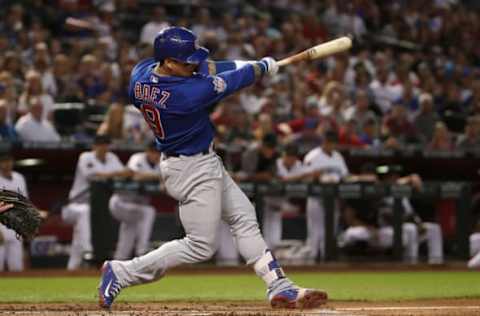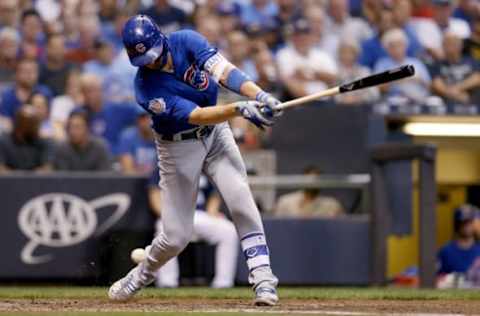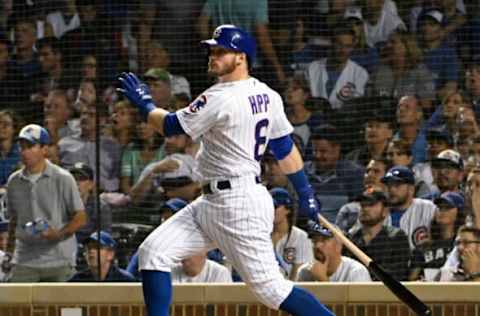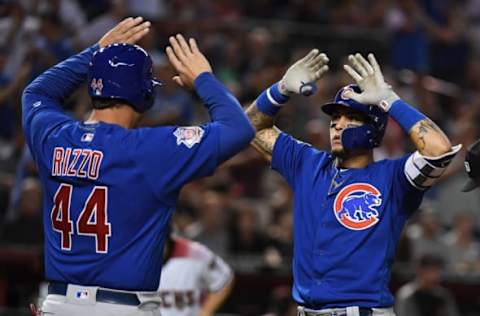Chicago Cubs are ready to battle against postseason aces in October


Over the past month, the offense has been less than stellar. But, fear not – the Chicago Cubs bats are ready for a huge postseason performance in October.
More important than just getting ready to play close and tight games, the Chicago Cubs are ready for playoff caliber starting pitching. In fact, statistics over the past month suggest the Cubs would rather face great starting pitching in the coming weeks. Don’t believe me? Please read on.
In 21 games from Aug. 27 to Sept. 17, the Cubs went 12-9, for a winning percentage of .571, only slightly below their .586 for the season. So, while we felt a major slide with the offense, our winning percentage basically remained constant. And it wasn’t just your imagination feeling as though the offense was underperforming; over that 21-game stretch I referenced, the Cubs scored only 3.67 runs per game (77 in 21 games) compared to their 4.69 runs per game clip for the season (703 in 150 games heading into Wednesday’s game in Arizona).
So, that begs the question – how did we win those games? Well, with pitching, of course. But, that simplistic answer belies how we really did it, and how we fared in different games throughout that stretch.

Chicago Cubs: Kicking it up a notch against the best
In those 21 games, the Cubs faced seven starting pitchers (Jacob deGrom, Mike Foltynewicz, Aaron Nola, Jhoulys Chacin, Max Scherzer, Chacin again and Patrick Corbin) who are in the top 30 in Fangraphs total WAR for pitchers this season.
In those games, we went 6-1. That means in all the other games, against starting pitchers outside the top 30 this season, we were mediocre, going 6-8. When you delve into the numbers, it gets even crazier (or hopeful, if you’re a believer that the Cubs can make another World Series run this postseason).
In the seven games against top 30 pitchers, we scored 2.71 runs (19 total in 7 games) off the starting pitcher. In the 14 games against pitchers not in that top 30 group, we scored 1.57 runs against each starter (22 total runs in 14 games).
Your eyes didn’t deceive you; we actually scored 1.14 runs more against great starting pitchers during that span than we did against mediocre or bad (at least this year) starters.

Chicago Cubs: Expanding the viewing glass
To continue this seemingly crazy anomaly, I’ll throw in some of the elite-caliber pitchers we faced in this stretch who aren’t even in the top 30 in WAR for 2018 (add Noah Syndergaard, Stephen Strasburg and Matt Harvey).
More from Cubbies Crib
- Cubs should keep close eye on non-tender candidate Cody Bellinger
- Cubs starting pitching has been thriving on the North Side
- Make no mistake: the Cubs are very much about power hitters
- Cubs are giving pitcher Javier Assad a deserved shot
- Cubs: It’s time to start thinking about potential September call-ups
Those are the kind of arms and postseason studs we are likely to see throughout the playoffs, even if we don’t have to face those guys specifically.
Adding those three guys makes 10 games during that 21-game stretch in which we faced a pitcher having a great 2018 or a one-time stud who didn’t have the same kind of year in 2018 they’re used to having (either because of injury or, in Harvey’s case, a little bit of a career derailment that seems to have righted itself in Cincy).
In those 10 games against postseason quality starting pitchers, we went 9-1, with our only loss coming to Max Scherzer (who we just so happened to beat earlier in the summer).
That means the games in which lesser quality pitchers started ultimately gave us a abysmal 3-8 record during that span.

Chicago Cubs: Putting it all together
What do all these numbers, decimals, records, and names mean? Maybe nothing because it’s a very small sample size and I hand-picked the parameters. (Although, I picked those parameters because I was noticing we were still beating a plethora of really good pitchers in the midst of an offensive funk, but we didn’t have a garish winning percentage) But, then again, maybe it does mean something.
Maybe the Cubs are more focused and engaged against great pitchers. Maybe players find a way to scrap, fight, and claw their way to a victory against those stud pitchers, maybe Joe Maddon manages differently, or maybe different combinations of players are used to win in those specific games.
Whether these numbers and records mean something tangible or not, it’s clear that down the stretch, the Cubs know how to win tight ball games against good pitching. They are very good at running up pitch counts early, chasing starters, and then coming back or adding on against relievers. Does this sound like a recipe for success?
Next. Jose Quintana surging at the right time. dark
Honestly, it sounds a lot like the 2016 version of the Cubs minus some offense. And maybe, just maybe, we started to see a little of that missing offense starting to click out in the desert this week.